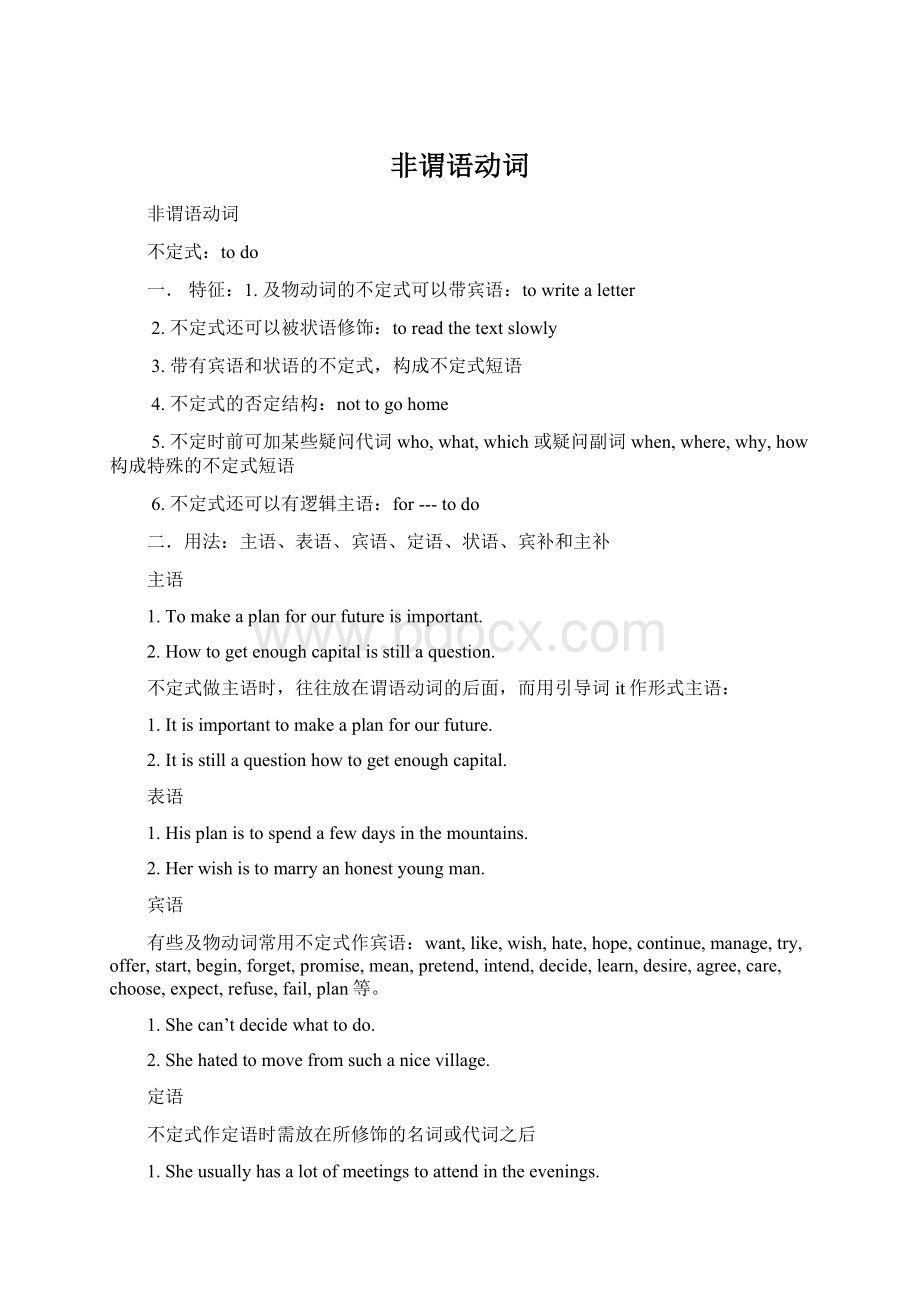非谓语动词.docx
《非谓语动词.docx》由会员分享,可在线阅读,更多相关《非谓语动词.docx(9页珍藏版)》请在冰豆网上搜索。

非谓语动词
非谓语动词
不定式:
todo
一.特征:
1.及物动词的不定式可以带宾语:
towritealetter
2.不定式还可以被状语修饰:
toreadthetextslowly
3.带有宾语和状语的不定式,构成不定式短语
4.不定式的否定结构:
nottogohome
5.不定时前可加某些疑问代词who,what,which或疑问副词when,where,why,how构成特殊的不定式短语
6.不定式还可以有逻辑主语:
for---todo
二.用法:
主语、表语、宾语、定语、状语、宾补和主补
主语
1.Tomakeaplanforourfutureisimportant.
2.Howtogetenoughcapitalisstillaquestion.
不定式做主语时,往往放在谓语动词的后面,而用引导词it作形式主语:
1.Itisimportanttomakeaplanforourfuture.
2.Itisstillaquestionhowtogetenoughcapital.
表语
1.Hisplanistospendafewdaysinthemountains.
2.Herwishistomarryanhonestyoungman.
宾语
有些及物动词常用不定式作宾语:
want,like,wish,hate,hope,continue,manage,try,offer,start,begin,forget,promise,mean,pretend,intend,decide,learn,desire,agree,care,choose,expect,refuse,fail,plan等。
1.Shecan’tdecidewhattodo.
2.Shehatedtomovefromsuchanicevillage.
定语
不定式作定语时需放在所修饰的名词或代词之后
1.Sheusuallyhasalotofmeetingstoattendintheevenings.
2.Shewastheonlyonetolookafterthechild.
状语
1.In1918,hewenttoJapantostudymedicalscience.(目的状语)
2.Heliftedarockonlytodropitonhisownfeet.(结果状语)
3.Thegirlsjumpedwithjoytohearthenews.(原因状语)
不定式常用在,,enough,so---as,soas,inorder等词或词组之后,作目的、结果、程度等状语:
1.Heisnotoldenoughtodriveacar.
2.Goinquietlysoasnottowakethebaby.
3.Marywouldn’tbesocarelessastoforgetherkey.
宾语补足语
ask,tell,invite,force,get,allow,wish,want,like,hate,help,leave,expect,prefer,encourage,advise,persuade,permit,remind,request,order,warn,mean,cause
1.Heaskedyoutocallhimbackat11.
2.Pleaseremindmetotakemymedicinetomorrow.
3.Theydidn’tallowhertoparkthecarinthisstreet.
有些及物动词的复合宾语中做宾语补足语的不定式不带to:
make,let,see,hear,watch,notice,feel
Mrs.BrownmademestayinNewYorkfortwomoreweeks.
Didyounoticehimleavethehouse?
Shewon’tletherpoorsonsufferlikethis.
主语补足语
带有宾语及宾语补足语结构的动词,变为被动态时,原宾语变为主语,原宾补则变为主语补足语。
注:
不定式作主补时,即使在make,let,see等动词后,不定式符号to也不能省略。
1.Hewasaskedtomakeaspeechatthemeeting.
(Iaskedhimtomakeaspeechatthemeeting.)
2.Shewaswarnednottobuyanoldcar.
3.Theyweremadetoworkdayandnight.
4.Someonewasheardtocomeupthestairs.
三.时态和语态
一般式:
todo
不定时的一般式所表示的动作,通常与主要谓语动词的动作或状态几乎同时发生或在其后发生。
1.Shewasseentoenterthehall.
2.Ihavesomenewstotellyou.
进行式:
tobedoing
不定时的进行式所表示的动作,通常与主要谓语动词的动作同时发生。
1.Theyseemtobegettingalongquitewell.
2.Theyaresaidtobebuildinganotherbridgeacrosstheriver.
3.Hepretendedtobelisteningattentively.
完成式:
tohavedone
不定时的完成式所表示的动作,发生在主要谓语动词所表示的动作之前。
1.Iamsorrytohavekeptyouwaiting.
2.Sheseemstohavereadthebookbefore.
3.HeissaidtohavewrittenanewbookaboutmodernbusinessEnglish.
被动式:
tobedone
1.Itisanhonorformetobeaskedtospeakhere.
2.Hewantedthelettertobemailedatonce.
3.Shepreferredtobegivenmoreworktodo.
但在有些句子中,虽然不定式与最近的名词或代词有动宾关系,但与句中另一个名词或代词却可能有主谓关系。
这时不定式常用主动式。
1.Hehasnoonetotakecareof.
2.Westillhavemanydifficultiestoovercome.
3.Givehimsomebookstoread,please.
分词
一.特征:
1.及物动词的现在分词可以带宾语:
tellingastory
2.分词还可以被状语修饰:
writingslowly,madeinChina
3.带有宾语和状语的分词,称为分词短语
现在分词doing,表示主动,表示动作正在进行:
burningforest,burningskin
过去分词done,表示被动,表示动作已经完成:
developingcountriesdevelopedcountries
二.用法
分词的作用相当于形容词和副词,在句中可以担当定语、表语、状语、宾语补足语,主语补足语。
定语:
单个的分词作定语通常放在被修饰的名词之前;分词短语放在被修饰的名词之后。
但有时单个的过去分词也可放在被修饰的名词之后。
1.Heoftenhelpshisworkingwifeathome.
2.Whoistheladystandingbythedoor?
3.Themembersofanextendedfamilyarecalledrelatives.
4.Wecanseeonlythepartofthemoonlightedbysunlight.
5.Theydecidedtochangethematerialsused.
表语
1.Thenewsisexciting.
2.Don’tgetexcited,please.
3.Shelookeddisappointed.
4.Thedoorremainedlocked.
5.Thestoryofhislifesoundsinteresting.
状语:
分词(短语)常用来做状语,表示时间、原因、方式、结果、条件、让步和伴随等。
做状语的分词通常放在句首或句尾,有时也可插在句子的主谓之间。
分词作状语时,它的逻辑上的主语应与主句的主语一致。
1.Relyingourownefforts,weovercameallthedifficulties.(原因)
2.Hearingthenews,theyalljumpedwithjoy.(时间)
3.Thestudentswentoutofschool,laughingandtalking.(伴随)
4.Givenbetterattention,thetreescouldgrowbetter.(条件)
为了表示明确的时间或条件,有时可在分词前加when,while,if等连词:
1.Whenleavingtheairport,shewavedagainandagaintous.
2.Whilewaitingforthetrain,IhadalongtalkwithJane.
3.Iftranslatedwordbyword,thesentencewillbemeaningless.
注:
有时分词也可以有自己独立的逻辑上的主语(即与主句的主语不一致),这种结构成为“独立结构”(absoluteconstruction),表示时间、原因、条件、伴随的动作或情况。
1.Theholidaysbeingover,theybegantogetdowntodotheirworkagain.(时间)
2.Somanypeoplebeingabsent,wedecidedtoputthemeetingoff.
(原因)
3.Weatherpermitting,thefootballmatchwillbeplayedonWednesday.(条件)
4.Wewentfarintotheforest,herfatheractingastheguide.(伴随)
有时,这样的独立结构还可用介词with引导:
with+---+a./ad./prep./doing/done
Withtearsrollingdownhercheeks,shecarefullycoveredhermother’sbodywithsand.
宾补和主补
1.Don’tyouseehimcomingtowardsus?
2.Shesuddenlyheardsomeoneknockingatthedoor.
3.Youshouldkeptherinformedofwhatisgoingonhere.
4.Shewassurprisedtofindherroomthoroughlycleanedandeverythingarrangedingoodorder.
当谓语动词变为被动语态时,原主动语态中的宾语变为主语,原宾语补足语则变为主语补足语。
1.Thehallwasfoundthoroughlycleanedandeverythingarrangedingoodorder.
2.Thechildrenwereheardsingingthesong.
3.Wewerekeptwaitingformorethanthreehours.
在see,hear,feel,watch,notice等动词后,即可用现在分词,也可用不带to的不定式作宾语补足语。
现在分词强调动作正在进行和发展中,不定式表示动作的全过程已经结束。
1.Shesawthemangettingonthetruck.
2.Shesawthemangetonthetruckanddriveoff.
三.现在分词的时态和语态
完成式:
havingdone
现在分词的完成式表示的动作在谓语动词所表示的动作之前发生。
1.Havingdonehishomework,theboybegantowatchTV.
2.Havingwateredthevegetables,thefarmertookashortrest.
3.Nothavingdoneitright,hetriedagain.
被动式:
beingdone
现在分词的被动式不仅表示被动的动作,而且表示这个动作正在发生或与谓语动词的动作同时发生。
1.ThebridgebeingbuilttherewillbeoneofthelongestinChina.
(正在进行)
2.Beingsurrounded,theenemywereforcedtoputdowntheirguns.(正在进行)
3.Hefoundthetopicbeingdiscussedeverywhere.(同时发生)
完成被动式:
havingbeendone
现在分词的完成被动式不仅表示被动的动作,而且表示这个动作在谓语动词所表示的动作之前发生:
1.Havingbeengivensuchagoodchance,howcouldshegiveitup?
2.Havingbeentoldthatsomeguestswerecoming,sheshoppedallmorninginthatsupermarket.
动名词
一.特征:
动名词兼有动词和名词的某些特征
1.及物动词的动名词可以带宾语:
readingabook
2.动名词还可以被状语修饰:
readingslowly
3.带有宾语和状语的动名词,称为动名词短语
4.动名词还可以用物主代词或名词所有格修饰,作动名词的逻辑主语
二.用法:
动名词在句中可做主语、表语、宾语、介词宾语、定语
主语
1.Talkingmendsnoholes.
2.Readingaloudisveryimportantinlearningaforeignlanguage.
动名词做主语时,也可用引导词it作形式主语放在句首,实际主语(动名词)放到句尾。
1.Itisnouseaskingheradvice.
2.Itisawasteoftimediscussingsuchmatters.
表语
1.Herjobisnursingthedisabled.
2.Readingislearning,butapplyingisalsolearningandthemoreimportantkindoflearning.
注:
动名词和不定式都可以做主语和表语。
一般说来,在表示比较抽象的一般行为时,多用动名词;在表示具体某次动作或将来发生的动作时,多用不定式。
1.Smokingisnotallowedhere.
Tosmokesomuchisnotgoodforyou.
2.Theirjobisbuildinghouses.
Theirworkistobuildanotherbridgeacrosstheriver.
宾语
下列及物动词及短语常用动名词作宾语:
avoid,finish,suggest,stop,mind,enjoy,require,postpone,delay,practice,risk,consider,miss,imagine,deny,escape,putoff,giveup,keepon,can’thelp
1.Shesuggestedspendinganotherdayinthemountainareas.
2.Healwaysavoidsgivingusadirectanswer.
●require后面的动名词具有被动意义。
Doesyourcarrequireservicing(repairing)?
即可用动名词,又可用不定式作宾语,且意义上差别不大的动词有:
Love,like,hate,prefer,begin,start,continue,intend,attempt,propose,deserve,need,can’tbear,can’tafford
1.Doyoulikeplaying(toplay)chess?
2.Shecan’tbearseeing(tosee)hersontreatedlikethis.
●need,want后面的动名词具有被动意义
1.Yoursuitneedsironing.(---tobeironed)
2.Theplantswantwatering.(---tobewatered)
●在start,begin,cease之后,如果表示有意识的开始或停止某动作,多用动名词;如果动作自动或突然开始或停止,则多用不定式
Hebegantalkingabouthisplanforsummerholidays.
Suddenlyitbegantorain.
●在下列动词后,动名词作宾语和不定式作宾语,意义差别较大
rememberdoing---记得做过---remembertodo---记得去做---
forgetdoing---忘记做过---forgettodo---忘记去做---
regretdong---后悔做过---regrettodo---遗憾地去做---
want/needdoing需要---wanttodo---想要---
meandoing意味着---meantodo---打算---,准备---
trydoing---尝试,试一下
trytodo----设法,试图---
goondoing---继续干同一件事
goontodo---接下来干另外一件事
stopdoing---停止做---stoptodo---停下来去做---
介词宾语
动名词作介词的宾语,构成介词短语,在句中作定语,状语,表语。
1.Man’sdreamofflyinginspacehascometrue.
2.Sheleftwithoutsayinggoodbyetous.
3.I’mforputtingtheexamoffforaweek.
定语
单个动名词作定语,放在被修饰的名词之前
drinkingwaterdrawingpaper,readingmaterials
●动名词作定语与现在分词作定语有所不同:
动名词和它所修饰的名词在逻辑上没有主谓关系,前者不是后者发出的动作;动名词表示的多是被修饰名词的功能、用途。
而现在分词作定语时,现在分词和它所修饰的名词在逻辑上有主谓关系,前者是后者发出的动作。
workingmethod(methodforworking),
workingpeople(peoplewhowork)
walkingstickwalkingtractor
sleepingcarsleepingchild
singingpracticesinginggirl
三.时态和语态
一般式doing:
动名词的一般式所表示的动作通常与谓语动词所表示的动作同时发生,或在其后发生。
1.Childrenenjoyreadingpicture-storybooks.
2.Heonlytookinterestinbuyingasecond-handcomputer.
完成式havingdone:
动名词的完成式表示的动作通常发生在谓语动词的动作之前
1.Iapologizefornothavingkeptmypromise.
2.Iregrethavingtoldherthenews.
●在某种情况下,也可用动名词的一般式代替完成式,尽管动名词的动作发生在谓语之前
1.Thankingyouforgivingussomuchhelp.
2.Onreturninghome,shefoundherfatherhadbeensenttohospital.
被动式beingdone:
当动名词逻辑上的主语是动名词动作的对象时,动名词一般要用被动形式。
1.Heinsistedonbeingtreatedasanordinaryemployee.
2.Shedidn’tmindbeingleftaloneathome.
完成被动式havingbeendone
动名词的完成被动式即表示动名词所表示的动作在谓语动词的动作之前发生,又表示动名词逻辑上的主语是动名词动作的对象
Afterhavingbeeninterviewed,hewasofferedthejob.
四.动名词的逻辑主语
动名词可用物主代词或名词所有格来修饰,表示动名词逻辑上的主语
1.Doyoumindmymakingasuggestion?
2.I’mpleased